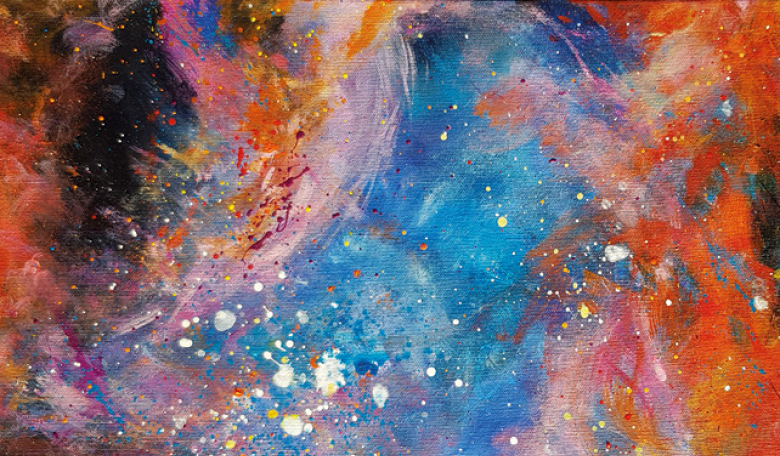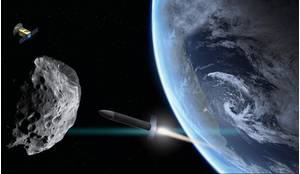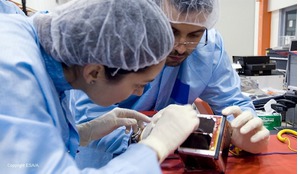The photographic detail of astronomical imagery has inspired earthbound artists for decades - and the starry night for centuries before that. In this article, a British artist explains how she got into art and displays some of her recent creations.
I love colour - you need only glance at some of my work to realise this. My paintings, inspired by the incredible space imagery now available, aim to resonate with the energy of space and express the emotions that the imagery evokes in so many people. But I haven’t always been an artist.
Industrial roots
After university, I was hired by the Institution of Electrical Engineers (now The Institution of Engineering and Technology, IET) where I applied my creative writing degree to promote participation in engineering events. The connections I made during those early days after graduation, showed me the humour, resilience and ingenuity within the engineering community and, over time, I longed to play a more significant role in bringing members of this community together. As time passed, I was invited to help in the rebranding of the institution and so began the application of my artistic skills alongside creative written content.
 In my paintings I am trying to resonate with the energy of space and I work rapidly to build free-flowing layers of acrylic paints
In my paintings I am trying to resonate with the energy of space and I work rapidly to build free-flowing layers of acrylic paints
I developed marketing materials for the engineers I worked with to help generate excitement around topics for which they sought wider engagement. This included product brochures, speeches for VIPs at prestige lectures and the design of award ceremonies - and I ran events with a sense of humour! I travelled with my work and I saw that no matter the topic, or where in the world an event was, I consistently produced my best work when I felt the freedom to act instinctively and creatively.
Following a decade with the IET, I was hired by defence technology company QinetiQ’s marketing director and worked on the rebranding of the organisation as well as the promotion of cutting edge technologies across both transport and space.
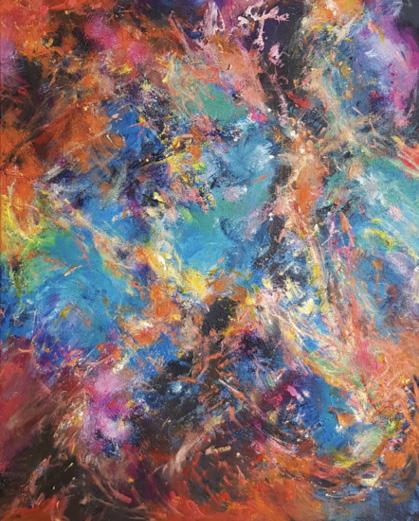 I let my colours run riot as I worked to capture the Butterfly Nebula’s wingspan which covers over three light-years. The painting is inspired by a 2009 close up from the Hubble Space Telescope’s Wide Field Camera 3, installed during the final shuttle servicing mission. I worked in almost neon pinks and yellows to reflect the 250,000 degrees Celsius heat within the subject.
I let my colours run riot as I worked to capture the Butterfly Nebula’s wingspan which covers over three light-years. The painting is inspired by a 2009 close up from the Hubble Space Telescope’s Wide Field Camera 3, installed during the final shuttle servicing mission. I worked in almost neon pinks and yellows to reflect the 250,000 degrees Celsius heat within the subject.
I was affected by the team-working I saw and driven to further appreciate end-users of technologies, such as members of the military who often visited the technologists based on the Farnborough, Hampshire, site. With QinetiQ, I used my creative flair to help describe the heritage of the organisation and I listened to the engineers to tailor my messaging (both written and visual) to aid their conversations and work progress.
After QinetiQ, I was appointed Head of Marketing and Communications with space technology start-up Celestia Technologies Group. More travel came my way - I loved seeing antenna testing technologies and meeting the brilliant minds behind the kit. I used my artistic eye to deliver visual messaging to harmonise the look and feel of marketing collateral across the Celestia Group, and I added to my experience of attending tradeshows - all the time cementing in my mind the value of making a good first impression in the increasingly crowded space industry.
Art-world beckons
I knew I wanted to contribute to the visual atmosphere of space technology companies and I could do this by making paintings
I believe that a good first impression comes down to a company being comfortable with its look and feel and thus being cohesive in who they are and how they operate. Looking to my skillset, I knew I wanted to contribute to the visual atmosphere of space technology companies and I could do this by making paintings. My goal was to give these brilliant creators of space technology a chance to rest their eyes and enjoy a contemplative mood in their reception areas and meeting rooms.
It took a coffee table book of images from the Hubble Space Telescope for me to appreciate the opportunity for space imagery to be recreated as works of art. I was fortunate to have met a number of space technologists who had worked on many aspects of Hubble, so now perhaps I could celebrate the beauty of their work by way of my own artistic creations. I’d been a little lost until that point: since graduation I had always enjoyed seeing how my work could bring technologists together to share perspectives and drive their work forward, but I was always on the edge of the action. Then I thought, “This is it!”
I soon realised that, for me, creating paintings is a very physical undertaking - stretching, bending, mixing, moving – and my classical ballet training was coming into play. Making space-inspired paintings ‘felt right’, as I moved to music, let my mind wander and explored the phenomenal images of space. I work rapidly to build free-flowing layers of acrylic paints.
I lose myself within the imagery of space and let each painting I create build organically, meaning that the finished piece can be intense or jubilant, light or sensuous or all of the above. I try to take each painting beyond a literal representation to let the pieces speak with their own mood and atmosphere. Each painting is a one-off and each is intended to be vibrant, interesting and enjoyable. I have been told by those who enjoy my work that I am “a joyful painter with a natural, dynamic use of brush strokes and colour.”
I have always liked to work on stretched canvas, using vibrant acrylics and inks to create pictures featuring constellations. In the early days, I often worked with NASA’s Astronomy Photo of the Day and have painted The Pillars of Creation, Seahorse Nebula, Carina Nebula, the Tarantula Nebula, the Butterfly Nebula and many more. My paintings have been used as a book cover and even printed onto silk for the lining of bespoke business garments as unique as their wearer. I work quickly when inspired and the turnaround time for a painting is around three weeks.
Exhibiting space
Exhibiting at space technology conferences is thrilling, and it really plays to my introvert/extrovert personality. I know I’m a calmer person if I’ve spent a day in the studio, but it’s an unbeatable feeling to meet with the brilliant minds who drive the technology to capture imagery of space and hear firsthand their responses to my work.
I just love the fact that colour is applied to information gathered in space as a means of interpreting the data and bringing understanding to it
I just love the fact that colour is applied to information gathered in space as a means of interpreting the data and bringing understanding to it. I add my own human imperfections and add layer upon layer of paint in a bid to draw attention to the beauty of the work of these awesome engineers. I also love the fact that my paintings appeal to audiences who are both directly a part of the space industry and those utterly separate from it.
In 2023 I exhibited at Space Comm Expo in Farnborough when one of my paintings was selected by the UKSpace Association as a raffle prize to encourage engagement with their exhibition stand. In October 2023, I gifted the British Interplanetary Society a painting in recognition of its 90th year. They chose to raffle ‘Stars of Open Cluster IC 1590’ during the Reinventing Space conference in Liverpool to raise funds for the society.
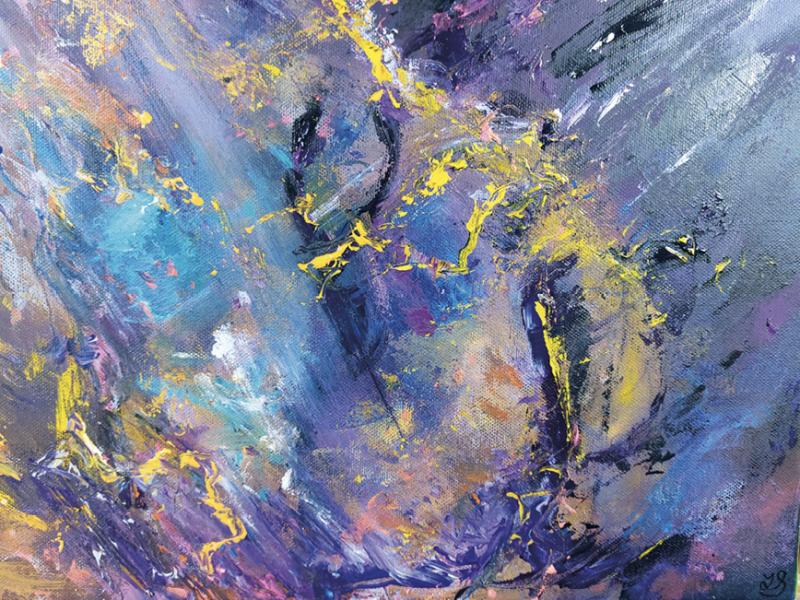 During an exhibition as part of the recent British Interplanetary Society’s Reinventing Space Conference, a friend shared some photos of his creations inspired by imagery taken by the HiRise camera on Mars. I was blown away by the textures and colours of the imagery and had to get paint on canvas to try to express my reaction to this image of the deep canyon walls of Valles Marineris. Imagery from HiRise inspires me visually and emotionally, and I react to my appreciation of the incredible minds which have collaborated to capture such amazing imagery. In my painting, you can see ancient crustal materials and bedrock with diverse colours which may have resulted from heavy bombardment by asteroids about 3.9 billion years ago.
During an exhibition as part of the recent British Interplanetary Society’s Reinventing Space Conference, a friend shared some photos of his creations inspired by imagery taken by the HiRise camera on Mars. I was blown away by the textures and colours of the imagery and had to get paint on canvas to try to express my reaction to this image of the deep canyon walls of Valles Marineris. Imagery from HiRise inspires me visually and emotionally, and I react to my appreciation of the incredible minds which have collaborated to capture such amazing imagery. In my painting, you can see ancient crustal materials and bedrock with diverse colours which may have resulted from heavy bombardment by asteroids about 3.9 billion years ago.
Although I usually draw my inspiration from images from the Hubble and James Webb space telescopes, during the Reinventing Space conference someone alerted me to imagery of Mars from the HiRISE camera - the High Resolution Imaging Experiment on the Mars Reconnaissance Orbiter. I am now planning to create a whole swath of paintings featuring the red planet.
As to hopes and dreams for the future, I’d love to be posted as an artist in residence with a technology company and be the first person to apply my painterly thoughts to space intelligence. It would be so satisfying, personally, to visit my space-inspired paintings, as they hang in reception spaces, meeting rooms and even as exhibition stand backdrops. But I would also love to know that my paintings support technologists with clear communication of their brand image and, to some extent, strengthen and extend the spiritual resonance of their work. All that said, the simplest intention of my work is to create a good atmosphere or boost a viewer’s mood.
Acknowledgments
The author would like to thank Nick Potts, former Managing Director of Printech Circuit Laboratories, for his support, which allowed her space-inspired paintings to travel from Colorado to Bremen and ultimately reside all over the world. The contact with Nick stemmed from an introduction by Dr Stuart Eves, a cascade of kindness that helped to forge a way from the process of painting to identifying chances to exhibit and sell those creations.
About the author
Zoë Squires is a space artist who creates colourful representations of astronomical objects using acrylic paint. She has a degree in creative writing, which she applied in marketing and communications roles for space companies such as QinetiQ and technology start-up Celestia Technologies Group. She exhibits and sells her work at space conferences and online at www.zoe-squires.com. Some of the work used to illustrate this article may still be available and Zoe is happy to accept commissions.





